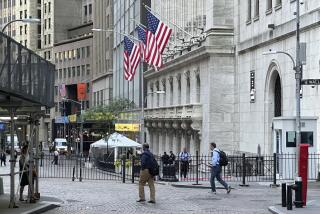Commodities Jump Sparks Inflation Fears : Economy: A key price index is at a five-year high. But some analysts say raw materialsâ role is a minor one.
Prices of key raw materials jumped Monday, boosting a closely watched commodity index to a five-year high and reigniting worries about inflation.
Surging prices of oil, cotton, silver and some grains drove the Knight-Ridder Commodity Research Bureau index of 21 commodities up 2.59 points to 239.92, the highest closing price since October, 1990, when the approaching Gulf War sent oil prices above $40 a barrel.
Commoditiesâ gains helped dampen an early rally in stocks and bonds on Monday, as some traders focused on the risk that rising raw materials costs could eventually translate into higher inflation at the consumer level.
But many analysts say the link between commodity trends and inflation isnât a strong one, because raw materials are usually a small part of total production costs.
In any case, the jump in commodities got Wall Streetâs attention on Monday. Oil led the charge, as September crude futures on the New York Mercantile Exchange gained 38 cents to $18.25 a barrel, the highest in more than two months.
Iraqi Lt. Gen. Hussein Kamel Majid, who defected to Jordan two weeks ago, told Western officials this weekend that Saddam Hussein planned a military attack this month, possibly against Saudi Arabia.
âEveryoneâs scared about whatâs going to happen in the Middle East and obviously that has a strong push to the upsideâ for oil prices, said a trader at Arco International Oil & Gas Co. in Plano, Tex.
At the same time, U.S. crude oil stockpiles are close to their lowest levels in 16 years, forcing refiners to buy the crude they need to meet summer gasoline demand and build heating oil stockpiles for the winter, analysts say.
In other trading Monday:
* Silver futures for September jumped 9.5 cents to $5.79 an ounce on the Comex in New York, a three-month high, as traders continued to react to mysteriously dwindling inventories.
The Comex said its silver stockpiles fell by a record 11.35 million ounces Friday to 154 million ounces, the lowest since 1987. Yet many analysts say physical silver isnât disappearing because of industrial demand, but rather because of hoarding by professional speculators.
* Cotton futures rose their 2-cent daily limit in New York, with the October contract closing at 82.75 cents a pound. The price has surged 11% in the past week amid reports that the boll worm and beet army worm have infested large areas of the Mississippi River valley.
* In Chicago, corn, wheat and hog futures advanced, reflecting the return of hot weather to the Midwest and the threat of further crop and livestock damage.
Economists say commodities generally represent only about 10% of the total cost of production, whether the end product is a loaf of bread or a cotton shirt. Labor typically is 70% of production costs, and even shipping and marketing costs can be more important than commodity prices for many goods.
Still, some experts warn that higher raw materials costs may at least keep inflation from going lower, which in turn could keep interest rates from falling further.
Commodities are likely to be among the topics of discussion at the Federal Reserve Boardâs policy meeting today in Washington.
âYou canât be too optimistic about inflation coming down when the CRB index is going up,â said John Silvia, chief economist at Kemper Securities in Chicago. âThatâs the bottom line.â
Indeed, higher grain prices this year, spurred by Midwest drought and strong global demand, have already translated into higher bakery prices, some experts say.
âThe industry has been able to pass the increases on in finished bakery products,â said Fred Bursey Jr., vice president at Morrison Milling, a wheat miller in Denton, Tex.
But many economists note that U.S. consumer price inflation has remained tame for the last two years--at about 3% or less per year--even though commodity prices surged in 1993. The CRB index shot up nearly 12% in 1993.
So far this year, the CRB is up just 1.4%, most of that in the past week.
Unless the global economy strengthens significantly, many experts say manufacturers will continue to have a tough time passing higher costs on to consumers.
âCommodity prices donât amount to a hill of beans at the end of the day,â said John Williams, global markets economist at Bankers Trust Co. in New York. Labor is businessesâ biggest cost, and labor markets âare amazingly well behaved,â he said, noting that pay raises remain muted across many industries.
Even so, with the CRB index at a five-year high, âpeople are starting to take notice of it,â said William OâNeill, director of futures research at Merrill Lynch.
(BEGIN TEXT OF INFOBOX / INFOGRAPHIC)
Prelude to Higher Inflation?
The Knight-Ridder Commodity Research Bureau index of 21 key commodities, which had been stuck in a narrow range since May, 1994, has surged in recent days and on Monday jumped 2.59 points to 239.92--its highest reading since October, 1990. Monthly closes, except latest:
Monday: 239.92
Source: TradeLIne
More to Read
Inside the business of entertainment
The Wide Shot brings you news, analysis and insights on everything from streaming wars to production â and what it all means for the future.
You may occasionally receive promotional content from the Los Angeles Times.







